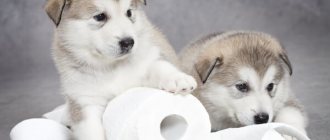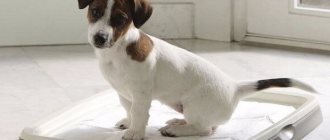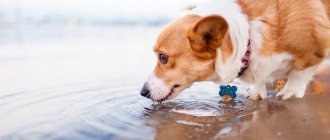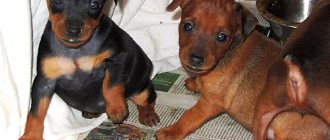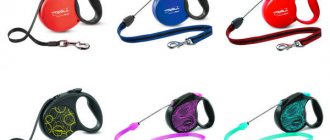Prostate diseases
In male dogs, an enlarged prostate gland causes constipation rather than difficulty urinating. Compression of the intestines makes the stool thin or ribbon-like. Due to abdominal pain, movements are constrained, the dog constantly presses his hind legs. But some prostate diseases can cause obstructed urine flow:
- hyperplasia (BPH) - a benign formation, a growing nodule or nodules;
- neoplasia – precancerous degeneration of gland cells;
- metaplasia – benign changes in tissue at the cellular level;
- abscess - a limited accumulation of pus;
- cysts - a pathological cavity, usually filled with fluid;
- prostatitis – inflammation of the prostate gland.
At risk are older, sedentary males who are overweight. In most cases, drug therapy involves hormones and provides temporary relief, so it is best not to delay surgery. Castration is indicated as a prevention of complications and relapses.
Obstruction of the urethra or bladder neck
An emergency condition in which urine cannot pass naturally. The causes of obstruction are stones, protein fractions, parasites, injuries, tumors. Rotting of the accumulated fluid leads to general intoxication, sepsis, kidney damage, and shock. Signs of urinary tract obstruction:
- the stomach is painful, full;
- frequent attempts to defecate;
- outflow in small portions drop by drop;
- impurities, turbidity, rotten smell of discharge;
- apathy, dehydration, intoxication.
A catheter is used to perform forced emptying and rinsing with an antibacterial solution. When this is not possible, the obstruction is removed surgically. A course of broad-spectrum antibiotics and anti-inflammatory drugs is required. Treatment is aimed at eliminating the underlying cause of obstruction and preventing recurrence.
Bladder rupture
Occurs due to excessive stretching of the walls due to prolonged stagnation of urine or trauma to the abdominal cavity - a fall from a height, an accident, a blow to the abdominal area.
Symptoms:
- there is an urge, but no urination;
- instead of urine, blood is released;
- the stomach is painful, tense;
- the dog walks on half-bent legs;
- due to bleeding, the mucous membranes are pale, temperature and pressure drop.
Even if we are talking about an incomplete rupture, this is a life-threatening condition. Possible sepsis, peritonitis, shock. Urgent surgical treatment is required - it is necessary to eliminate the consequences of the rupture and restore the integrity of the organ. A long-term gentle regime is required.
Bladder atony
Atony is a condition in which the walls of the bladder or skeletal muscles lose the ability to contract. This occurs due to diseases of the spine, spinal cord injuries, pathologies of the nervous system, and infections. The cause may be aging, inactivity, excessive stretching due to infrequent walking, adenoma or obstruction.
Symptoms:
- discharge is very scanty or absent at all;
- long pause before starting to urinate;
- weak stream or emptying drop by drop;
- protruding large belly;
- apathy, immobility;
With atony, incontinence also occurs, especially in large dogs. Treatment is aimed at eliminating the cause of dysfunction and preventing relapses. In addition to drug therapy, it is imperative to increase the frequency of walks, diet and exercises to strengthen the pelvic muscles - swimming helps a lot.
Anuria
A condition in which urine does not enter the bladder. Occurs with decreased cardiac function and severe kidney disease. The free flow may be obstructed by stones or compression of the urinary tract by a nearby tumor.
Symptoms:
- there are no urges or they are too rare;
- swelling throughout the body, often on the paws;
- depression, weakness, loss of appetite;
- thirst, nausea, vomiting after drinking;
- ascites - the abdomen is full of fluid.
Anuria is a life-threatening emergency condition. Products of protein metabolism accumulate in the blood, which can lead to uremic coma. It is important to quickly relieve intoxication, eliminate the cause of the disease or take control of it. The prognosis is cautious even with timely access to the clinic and a correct diagnosis.
Neoplasms
In most cases, we are talking about papillomas, polyps or a malignant tumor. If the neoplasm is localized in the organ cavity, there are no symptoms for a long time. But if the tumor prevents the outflow of urine, general signs of stagnation increase - abdominal pain, constrained movements, apathy, intoxication.
Neoplasms are more often diagnosed in older animals; their location is the cervix, ureter, urethra. Delay leads to atony, renal failure, wall rupture, and peritonitis. As a rule, surgical intervention is used to eliminate obstruction. The therapy is complex, aimed at eliminating the consequences of obstruction - antibiotics, antispasmodics, painkillers.
The role of water in the dog's body
Water plays an important role in a dog's body. It ensures the normal functioning of the vascular and digestive systems, and is responsible for the condition of the skin, wool, and mucous membranes. A normal volume of fluid helps eliminate toxins, and in hot weather, water participates in the process of thermoregulation due to gradual evaporation. Moisture is part of the connective tissue, due to which the joints soften and movements become easier.
Dehydration for more than 12 hours begins to affect the pet's condition. He becomes lethargic, movements and metabolism slow down. Thirst is especially dangerous in hot weather - the temperature balance is disturbed, which is fraught with serious complications from the cardiovascular system.
How much water should a pet drink per day?
The amount of water per day depends on weather conditions, physical activity, type of feeding and size of the pet. With dry food, more fluid is required, since the food causes a feeling of thirst after entering the stomach. The norm of fluid consumption for dogs is 20-70 ml per kg of pet weight per day. If your pet drinks less in cool weather, there is no need to worry. A dog can get moisture from natural food by eating snow, which is often found in huskies, malamutes and Samoyeds.
Photo: nellis.af.mil
Age characteristics
Incontinence is sometimes related to the dog's age. Puppies simply do not understand where and when they can void their urine; they need it more often than an adult dog, which is why unauthorized puddles sometimes appear indoors in a place other than the one designated for the toilet.
The smooth muscles of dogs weaken with age, which is why older animals pee more often than younger ones. There is no use scolding your pet. The only way out is to regularly use medications prescribed by the veterinarian.
For your information! Incontinence in a young bitch sometimes indicates the imminent approach of her first heat.
Signs of exhaustion and illness
If you find that your dog is not drinking enough water, you should check your pet for dehydration. To do this, use two fingers to pull back the skin at the withers or in the area between the shoulder blades. Normally, the coat with a layer of subcutaneous fat should quickly return to its place; slow drooping is the first sign of a lack of water.
The second way is to check the condition of your gums. In a healthy dog, they should be colored a rich red-pink color; with light pressure, the white tint that appears will immediately disappear. Dehydration is often accompanied by symptoms of exhaustion. The main ones:
- loss of appetite, refusal to eat;
- apathy, lethargy and poor mobility;
- reluctance to go for a walk or play;
- dullness of the eyes, change in the saturation of the iris shade;
- redness of the whites.
To check the dog's condition, you can offer it any treat, give it a toy, or call it for a walk. A healthy and active animal should not refuse these offers.
Diagnostics
When you arrive at the clinic or hospital, be prepared to tell the veterinarian any symptoms and behavioral changes you have seen in your dog who cannot pee. In most cases, the veterinarian will want to begin a full physical examination followed by a urine test, which may show infection or signs of inflammation. Blood tests including CBC and chemistry profile may be included.
© shutterstock
If the veterinarian has not diagnosed a simple infection or believes further investigation is necessary, a urethral catheter may be placed to rule out the possibility of a blockage. It is interesting to note that urethral obstruction is more common in male dogs due to the narrowing of the urethra on the penis.
Additional testing may include:
- Palpation of the abdomen - if the kidneys are full and the bladder is empty (anuria), this indicates a lack of urine output, which is the disease itself;
- CT to evaluate the caudal spine for tumors;
- Myelography (x-ray examination for damage to the spinal cord);
- Epidurography (X-ray test to check for spinal cysts);
- Abdominal ultrasound to check for kidney or bladder problems;
- Cystoscopy (insertion of a hose to examine inside the lower urinary tract).
Why does a dog refuse water?
Loss of thirst can occur due to many factors. There are the following reasons why a dog does not drink water well:
- Stale water and dirty dishes. Change the liquid in the bowl at least once a day. Wash the container itself with the addition of mild cleansers at least once a week. Otherwise, drool and dirt may accumulate in it, which contributes to the appearance of bacteria and waste. A typical sign of a dirty bowl is the dog sniffing the water and not drinking.
- Damage to the oral cavity. When drinking, the tongue curls up like a ladle, scooping up and sending water inside. If it is damaged or gum disease occurs, it becomes painful for the dog to drink.
- Diseases of the respiratory system. With a common cold or laryngitis, severe swelling appears in the larynx, which leads to discomfort and pain when drinking water, and it becomes difficult for the dog to swallow.
- Pregnancy. In the later stages, as well as after giving birth, bitches often refuse water.
- Recovery period after surgery. At this stage, dogs always feel weak and drink poorly.
- Diseases. Lack of thirst is observed in oncology, disorders of the genitourinary system, poisoning and viral diseases. Usually this symptom is accompanied by loss of appetite, weakness and malaise.
If you notice that your dog has stopped drinking water and looks exhausted, you need to contact a specialist. Early diagnosis allows you to avoid serious problems and the transition of the disease to the chronic stage.
Photo: flickr.com
If your puppy doesn't drink water
There is often a situation where a puppy eats well, but refuses the offered liquid. This may occur due to the fact that there is enough liquid in the food, as well as due to his inability to lap. The following reasons also occur:
- entry of a foreign body into the body;
- departure;
- viral or bacterial infection;
- intestinal obstruction;
- disruption of organ function.
First of all, you need to bring the puppy into the container, lower his head slightly so that his nose touches the water. If even after this the animal does not want to drink, you can use a bottle with a nipple or a small hole, depending on its age. If general weakness, fever and other symptoms are detected, the animal should be shown to a doctor.
Photo: maxpixel.net
Symptoms
The problem of why a dog can't pee can quickly become a pressing situation. Don't hesitate to take your dog to the vet if you see any of the following symptoms:
© shutterstock
- Urine that flows in streams or streams;
- Frequent attempts to urinate (often delayed and unsuccessful);
- Display of strain when attempting to excrete urine;
- Leakage (this can happen because the bladder is so full that it can no longer hold fluid);
- Blood in the urine;
- Licking the urinary opening;
- Low appetite;
- Vomit;
- Tender abdominal area;
- Lethargy;
- Disinterest in normal activities.
Consequences of not drinking
If your dog is eating but not getting enough water, this can lead to a number of serious problems. Possible consequences:
- decreased activity, lethargy and lethargy;
- change in skin tone;
- deterioration of joint function, pain when walking;
- disruption of the functioning of all internal organs;
- slowing down metabolism;
- departure against the background of stagnation of toxins in the body;
- development of chronic diseases.
A prolonged absence of water leads to severe exhaustion of the animal. If the necessary measures are not taken in time, this can result in death. This is why it is important to respond to signs of dehydration as quickly as possible, especially if you have an older dog.
How to train a dog to drink water
It is impossible to force them to drink water, but it is important to take proper care and provide favorable living conditions. Useful tips:
- Dogs require regular exercise. Long-term rest causes harmful substances to stagnate in the body, which leads to the development of diseases. When walking in the heat, take something to drink with you;
- Food should be given only at the designated time.
- Drinking water should always be available to the dog. When kept in a kennel, place the bowl at a distance accessible to the animal;
- reduce stress as much as possible, do not scold your pet if he does not want to drink;
- Normally, walking should be carried out at least once every 8 hours; if this is not possible, be sure to purchase a tray.
If the dog refuses water altogether, dehydration must not be allowed to occur. To do this, she needs to be given a rehydration solution, which can be purchased at the pharmacy. If the drug is not on hand, give your pet unsalted chicken broth or carrot juice diluted 1:1. As an emergency measure, it is permissible to pour water into the mouth with a syringe or syringe, placing it on the side under the cheek to avoid choking.
Some tips for litter box training your dog
Following these tips will help your pet learn to go to the right place faster.
- We create an environment of “routine”. The point is that a daily routine must be developed and strictly followed. It is necessary to feed the animal at exactly the same time, walk it, and even bathe it, preferably at a set time. In this case, the puppy or adult dog will learn to control its bladder and not empty it immediately when the urge arises. It is clear that this will not happen immediately, but a clear regimen will definitely be useful, including for general health.
- Today, a variety of diapers are gaining popularity. However, experts and experienced dog breeders do not recommend their use. Yes, some kind of diapers can be attractive from the point of view of simplifying care. But they definitely won’t help train him to use the tray, quite the opposite. And subsequent problems will accumulate like a snowball.
- If at first the puppy wears an absorbent diaper, assuming that he was trained this way before he came into your home, then the following actions are recommended. Move the material towards the tray or entrance door daily. Over time, if necessary, the dog will move to the litter box to go to the toilet. At some point in time, the diaper will end up in the tray, and then it will completely disappear. It will be replaced with filler. The same technique is relevant when training a dog to go outside for these purposes. Having rested against the door, the diaper is taken outside, and after a while it is removed altogether.
- Remember, no one is immune from mistakes. And small puppies, like those children, will periodically miss the tray or not reach it at all. You need to be prepared for this and have a very philosophical attitude without hysterics, screaming, and so on.
Follow us
Find out more about your animal's personality on our social networks
- Speaking of the owners' reaction. Under no circumstances, never hit the dog, don’t even scream. In this way you will only turn the dog against yourself without achieving a positive result. It is important to firmly say the word “NO” and take her to the tray. Another mistake that novice dog owners often make is poking their nose into a puddle. This is wrong and disrupts the dog’s sense of smell, which is critical, as you understand.
- And the other side of the coin. If the dog went into the litter box correctly, it must be rewarded. Praise her every time and stimulate her with treats. In this way, positive feedback will be formed, and the animal will understand what is required of it, and that everything is being done correctly and in a timely manner. In general, there is no such thing as too much praise, love your pet, be patient, and everything will work out for both of you.
- Plan your time clearly. The learning process, including litter box training, requires diligence and time. It is important to regularly, on a schedule, take walks and some educational elements. If you are not ready for the sacrifices that are definitely inevitable, both in work and in your personal life, then do not get a dog in the first place, do not torture yourself or the animal. No one will benefit from such a joint stay.
- Sometimes, during the initial period of an animal’s stay in the house, a small enclosure is built for it, where a tray is placed. A smaller space will allow your puppy to quickly understand where he needs to go to the toilet.
Briefly about the main thing
- Dogs require water for the normal functioning of their entire body. Lack of fluid leads to slow metabolism, exhaustion and disease.
- Dehydration can be determined by pressing on the gums or by pulling the skin between the shoulder blades.
- The average daily intake for dogs is 20-70 ml per 1 kg of weight. The total volume depends on the weather, lifestyle, and diet.
- If the dog is only eating and refuses water, he needs to be given a rehydration solution or forcefully injected with a syringe.
Has it ever happened to you that your dog refuses to drink at all? Share in the comments how you dealt with this problem.
